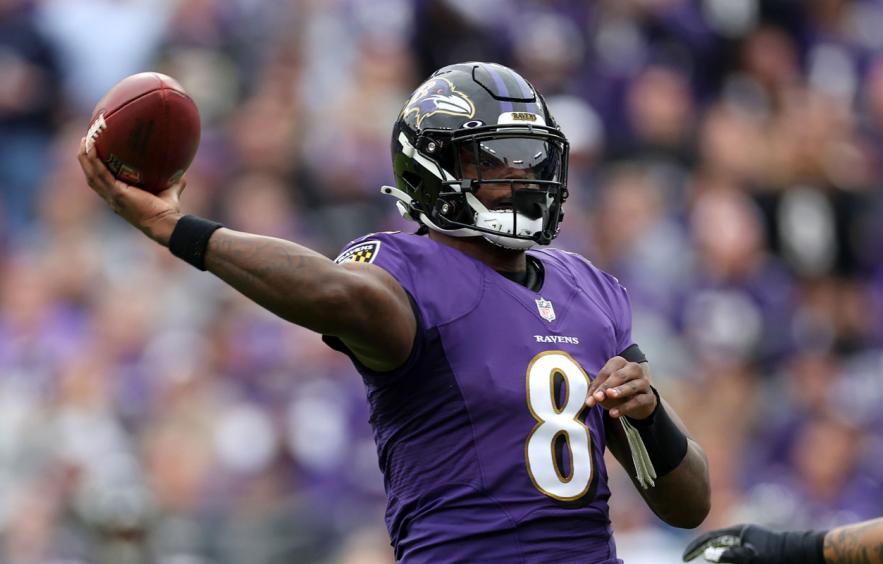The Most Predictable Quarterback Stats

When projecting player stats, it can be tempting to simply look at the previous season as a sign of things to come and build expectations accordingly. While this can be a valuable exercise, if the analysis is predicated on the wrong stats, the effort will be all for naught.
This study will shed some light on which commonly-referenced stats are the most reliable indicators of future quarterback performance, as well as which might be misleading.
More Predictable Stats: RB | WR | TE
This article has been updated to reflect data through 2022.
Quarterback Predictability Methodology
This study considered 12 common per-game statistics for quarterbacks who started at least 10 games in consecutive years. The decision to use per-game stats is based on the fact that total games played are extremely unpredictable for all positions—quarterbacks with an ADP in the top 200 over the last 10 years saw a year-to-year correlation of .05 for games played. Therefore, all year-long volume stats showed relatively little year-over-year correlation. Using this methodology, the sample is 232 quarterbacks over the last 10 sets of year-to-year data.
The table below lists the year-to-year correlations for 12 separate quarterback stats using the methodology described above.
| Stat | Y/Y Correlation |
|---|---|
| Rush Attempts/Game | 0.89 |
| Rush Yards/Game | 0.85 |
| Passing Yards/Game | 0.57 |
| Rush TD/Game | 0.56 |
| Completion % | 0.52 |
| Pass Attempts/Game | 0.52 |
| Sack Rate | 0.50 |
| Fantasy Points/Game | 0.44 |
| Passing TD/Game | 0.38 |
| Yards/Attempt | 0.31 |
| Interception Rate | 0.27 |
| Touchdown Rate | 0.26 |
Interpreting Volume
With an understanding of why per-game stats correlate so strongly from year to year, we can take a closer look at which are the most reliable in predicting the upcoming season for a given quarterback.
Of the per-game volume stats, passing yards are the strongest from year to year. All of the other per-game volume numbers (pass attempts per game, fantasy points per game, and touchdowns per game) have a moderate year-to-year correlation, but it's not to the point where you'd look at the previous season's numbers and feel comfortable projecting those numbers forward.
Also, note that touchdowns carry so much weight when it comes to fantasy scoring that their relatively low year-to-year correlation brings down the correlation for fantasy scoring as well.
The Smart Way to Use Efficiency
The relatively weak year-to-year correlations of the efficiency metrics lend some insight into why yardage is so predictable even though attempts might fluctuate from one year to the next. In fact, other than completion percentage, we cannot expect any of the commonly referenced efficiency metrics (yards per attempt, touchdown rate, or interception rate) to remain static from one year to the next
Consider the yearly touchdown rates of Lamar Jackson, one of three active quarterbacks with a career touchdown rate above 6%:
| Year | TD% |
|---|---|
| 2019 | 9.0% |
| 2020 | 6.9% |
| 2021 | 4.2% |
| 2022 | 5.2% |
Even the most efficient quarterbacks can have some huge swings in their touchdown-scoring tendencies from year to year—just two years ago, Jackson was coming off of consecutive seasons with a touchdown rate above 6% and that number dipped near the league averages in 2021. As such, the best application of efficiency metrics is usually to use the past season's data to gauge whether or not a quarterback is due for reversion (be it positive or negative) to the league average, or to his individual average if there's a large enough sample.
Understanding Rushing Numbers
The fact is that there are still quite a few quarterbacks who don’t run very much, leading to very low rushing totals from one year to the next—this explains the very strong correlation of rushing yards from year to year. If we narrow the sample down to quarterbacks who rushed for 15 or more yards per game, the correlation drops to 0.68. Quarterbacks who rushed for 20+ yards per game saw a correlation of 0.62. We see the same effect when looking at rushing touchdowns. If a quarterback scored at least four in a given season, the rushing touchdown correlation fell to 0.46. While quarterbacks that never run are very predictable, mobile quarterbacks usually see moderate fluctuations in their year-to-year numbers.
Bottom Line
Whether you're projecting player stats for an entire season or a single week, there are countless factors to consider outside of what happened in the past. During the offseason, though, numbers from the previous year are often the only hard data that we have to point to. Those numbers can be used as a reliable point of reference when the right factors are considered, and we now have an understanding of which stats are a sign of things to come for quarterbacks, as well as which ones might not serve as a future indicator.

















